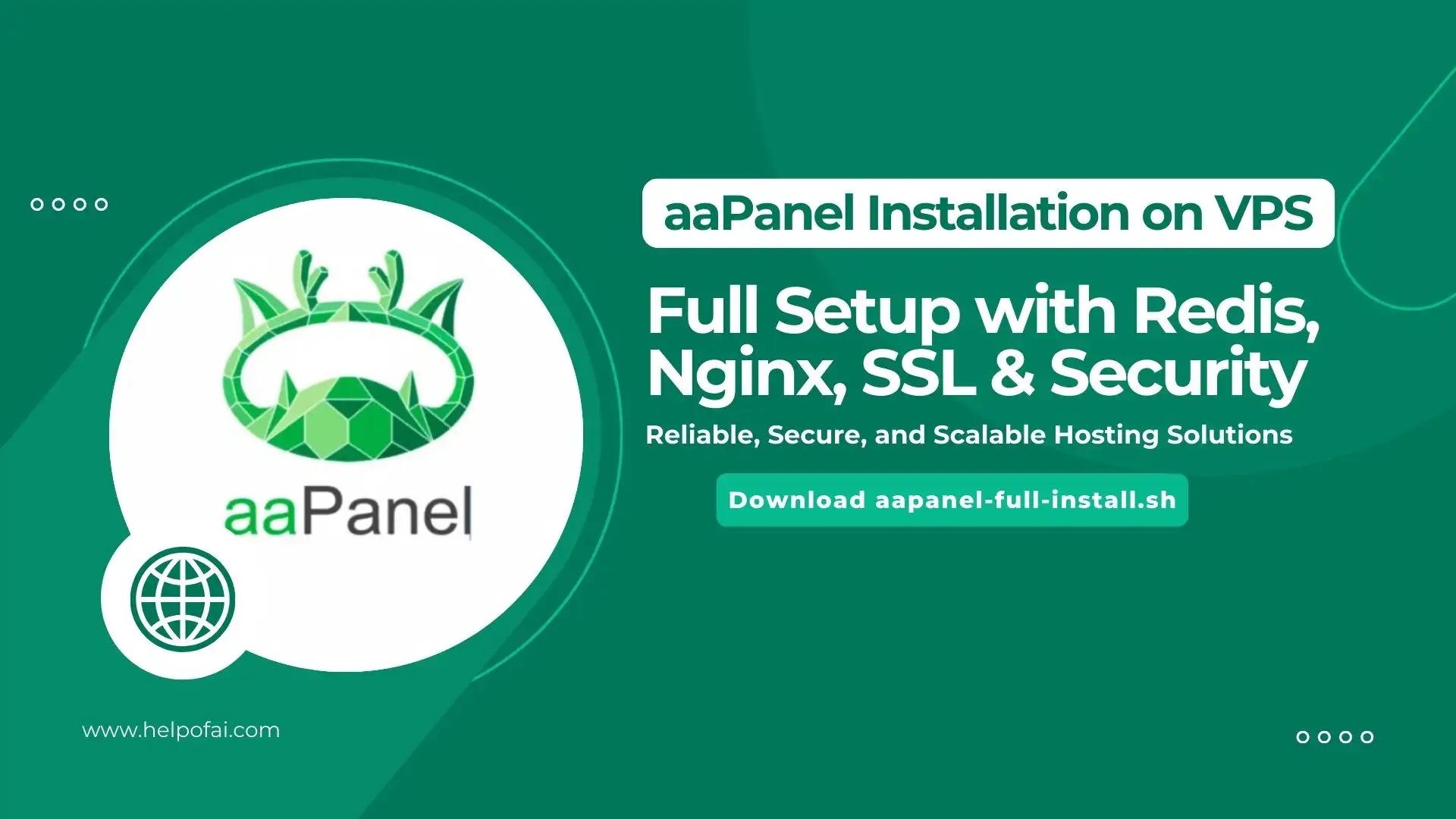The aaPanel is a versatile web hosting control panel known for its comprehensive yet user-friendly interface. While installing and accessing the aaPanel is the first step, mastering its vast array of commands is where true server management prowess lies. Let’s delve into these commands to ensure you maximize the potential of your helpofai.com VPS.
Step-by-Step aaPanel Installation
1. Connect to Your VPS
ssh root@your-server-ip
2. Update the System
For Ubuntu/Debian:
apt update && apt upgrade -y
For CentOS:
yum update -y
3. aaPanel Install
✅ For Ubuntu/Debian:
wget -O install.sh http://www.aapanel.com/script/install-ubuntu_6.0_en.sh && bash install.sh
✅ For CentOS:
yum install -y wget && wget -O install.sh http://www.aapanel.com/script/install_6.0_en.sh && bash install.sh
Post-Install Configuration
✅ Save These:
- Admin URL
- Username & Password
Open Firewall Ports (if needed)
Ubuntu:
ufw allow 8888
ufw allow 80
ufw allow 443
ufw allow 20:21/tcp
ufw allow 22
ufw reload
CentOS:
firewall-cmd --zone=public --add-port=8888/tcp --permanent
firewall-cmd --zone=public --add-service=http --permanent
firewall-cmd --zone=public --add-service=https --permanent
firewall-cmd --reload
Recommended Stack (LEMP or LAMP)
aaPanel will prompt to install a stack. Choose LAMP (Apache) or LEMP (Nginx).
✅ Suggested:
- Web Server: Nginx (lightweight & fast)
- PHP: PHP 8.1 or 8.2 (depends on app)
- DB: MySQL 5.7 or MariaDB 10.5+
- FTP: Pure-FTPd (if needed)
Performance Optimization Tips
✅ Use PHP-FPM (FastCGI)
Enable PHP-FPM in your PHP settings for better performance.
✅ Enable Opcache in PHP
vim /www/server/php/81/etc/php.ini
Uncomment or add:
opcache.enable=1
opcache.memory_consumption=128
opcache.max_accelerated_files=10000
opcache.revalidate_freq=2
✅ Use Redis for Caching
Install Redis from the aaPanel app store and configure it with your CMS (WordPress, Laravel, etc.)
✅ Gzip Compression (Nginx)
gzip on;
gzip_types text/plain application/javascript text/css application/json;
gzip_min_length 1000;
Security Best Practices
🔐 Change Default Port
Go to Settings → Panel Settings → Change port 8888 to something like 8822.
🔐 Enable SSL on Panel
Use Let’s Encrypt to secure the panel URL (https://yourdomain.com:port).
🔐 Set IP Whitelist
Only allow your IP to access aaPanel:
Settings → Security Settings → IP Whitelist
🔐 Set Strong Panel Login Credentials
Use a strong password and change username from default.
🔐 Auto Security Updates
Enable system updates (cron job) for security patches:
apt install unattended-upgrades
dpkg-reconfigure --priority=low unattended-upgrades
🔐 Install Fail2Ban
apt install fail2ban -y
systemctl enable fail2ban
Auto Backup Settings
- Go to aaPanel > Cron
- Create a task:
- Type: Backup
- Target: Sites/Databases
- Frequency: Daily/Weekly
- Storage: Local / Cloud (OSS, Dropbox, etc.)
Monitoring & Alerts
- Install System Monitor from the App Store
- Set up Email notifications in Settings → Notification
Would you like me to prepare a downloadable .sh script that installs and configures all of this automatically?

How to Use:
- Upload the script to your VPS or use
scp:cp aapanel-auto-install.sh root@your-server-ip:/root - SSH into your server:
ssh root@your-server-ip - Run the script:
chmod +x aapanel-auto-install.sh ./aapanel-auto-install.sh
This script also includes Redis, Nginx stack, or auto Let’s Encrypt setup.
inshort
1. Management Essentials with aaPanel Script:
The aaPanel management script is your command center, granting you the ability to control various server operations.
- Start the Service:
service bt start - Stop the Service:
service bt stop - Restart:
service bt restart - Uninstall aaPanel: For a complete removal:
service bt stop && chkconfig --del bt && rm -f /etc/init.d/bt && rm -rf /www/server/panel
2. Customizing and Securing the Control Panel:
Customization and security go hand in hand in ensuring an optimal server experience.
- View the Current Control Panel Port:
cat /www/server/panel/data/port.pl - Modify the Control Panel Port: Depending on your CentOS version, commands are available to adjust the default port (e.g., 8881).
- Force a Change to MySQL Manager Password: To ensure database security:
cd /www/server/panel && python tools.py root 123456 - Modify Control Panel Login: Bolster your security stance:
cd /www/server/panel && python tools.py panel 123456 - Delete Control Panel’s Domain Binding:
rm -f /www/server/panel/data/domain.conf - Lift Login Restrictions:
rm -f /www/server/panel/data/*.login - Control Panel Authorization IP: Review authorized IPs with
cat /www/server/panel/data/limitip.confand eliminate access restrictions withrm -f /www/server/panel/data/limitip.conf - Inspect Control Panel Permission Domains:
cat /www/server/panel/data/domain.conf - Deactivate Control Panel SSL for Troubleshooting:
rm -f /www/server/panel/data/ssl.pl && /etc/init.d/bt restart - Review Logs for Troubleshooting: Check out control panel error logs with
cat /tmp/panelBootand database error logs withcat /www/server/data/*.err.
3. Understanding Directories and Configuration Paths:
Path knowledge aids in quick navigation, backups, and alterations.
- Web Server Configurations: Nginx at
/www/server/panel/vhost/nginxand Apache at/www/server/panel/vhost/apache. - Default Site Directory:
/www/wwwroot - Backup Directories: Store your database backups in
/www/backup/databaseand site backups in/www/backup/site. - Site Logs: Easily accessible at
/www/wwwlogs.
4. Managing Core Services:
Here’s how to effectively manage and configure integral services like Nginx, Apache, MySQL, FTP, PHP, Redis, and Memcached:
- Nginx: Control the service with start, stop, restart, and reload commands. All configurations reside in
/www/server/nginx/conf/nginx.conf. - Apache: Harness similar control commands and inspect configurations at
/www/server/apache/conf/httpd.conf. - MySQL: Beyond the start, stop, restart, and reload commands, configuration details can be found at
/etc/my.cnf. - FTP: Manage with the provided start, stop, and restart commands, and refer to configurations at
/www/server/pure-ftpd/etc/pure-ftpd. - PHP: Depending on your version, utilize specific commands and adapt configuration paths accordingly.
- Redis: Command the service using start and stop, and modify configurations via
/www/server/redis/redis.conf. - Memcached: Efficiently manage using the given commands.
Conclusion:
By understanding and implementing the commands and best practices highlighted in this guide, you’re poised to achieve unmatched server management competency with aaPanel on helpofai.com VPS. Should you encounter any complexities, remember, helpofai.com’s expert support is just a click away, and you can always refer to www.helpofai.com/knowledgebase or www.helpofai.com/contact for in-depth assistance.